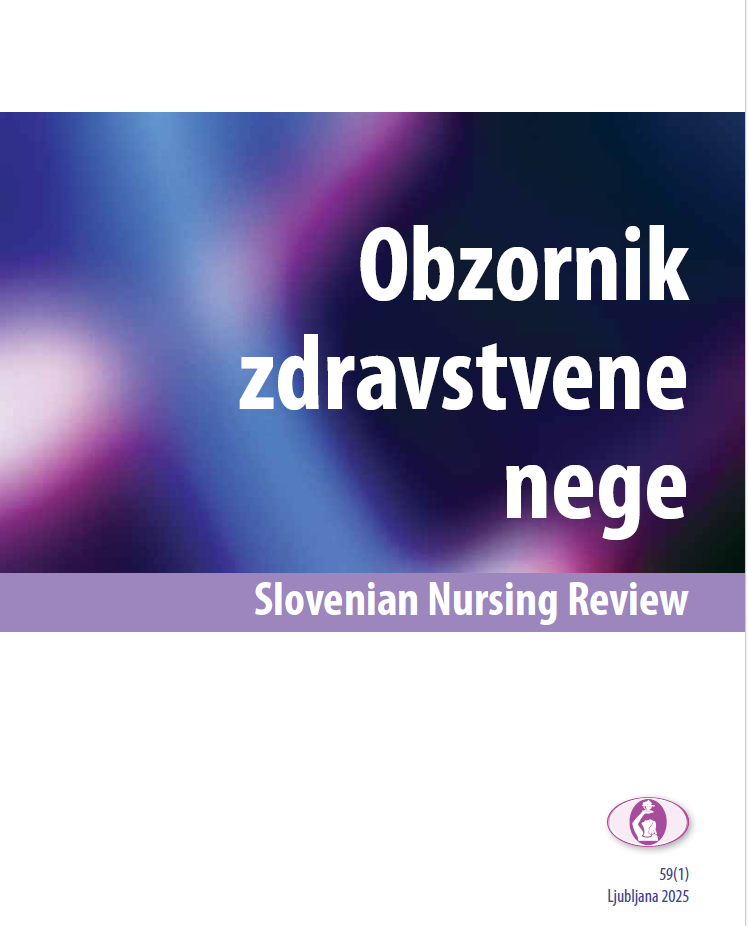Decline in the work ability of older nurses
A literature review
DOI:
https://doi.org/10.14528/snr.2025.59.1.3243Keywords:
Nursing, Aging, Older employeesAbstract
Introduction: The work ability in older nurses is often associated with stress and burnout in the workplace, the complexity of work duties and specific working conditions. The aim of this literature review was to examine and present current findings from the field of research on older nurses' work ability.
Methods: This literature review on the work ability of older nurses was conducted on the basis of a systematic analysis of scientific articles published between 2012 and 2022. The review and analysis included articles available in full text and indexed in the PubMed Central, Science Direct, and Cochrane Library bibliographic databases, as well as in Google Scholar.
Results: The literature search produced a total of 1181 hits, of which eight articles were included in the final analysis. the review of the current findings on this topic detected three thematic areas, namely: 1) work ability and burnout, 2) work ability and work environment, 3) work ability and the model of selection, optimisation, and compensation.
Discussion and conclusion: The work ability in nurses decreases with age. Based on the findings in the literature reviewed, we can conclude that the work ability of older nurses is insufficiently researched. With the ageing population of employed nurses and the demanding work conditions in the profession, this literature review provides the basis for further research in the field of nursing staff development.
Downloads
Metrics
References
Converso, D., Sottimano, I., & Balducci, C. (2021). Violence exposure and burnout in healthcare sector: Mediating role of work ability. La Medicina del Lavoro, 112(1), 58–67. https://doi.org/10.23749/mdl.v112i1.9906 PMid:33635295; PMCid:PMC802352
Čeledová, L., Babková, K., Rogalewicz, V., & Čevela, R. (2014). The work ability index for persons aged 50+ as an instrument for implementing the concept of age management. Kontakt, 16(4), 286–292. https://doi.org/10.1016/j.kontakt.2014.10.003
Ebener, M., & Hasselhorn, H. M. (2019). Validation of short measures of work ability for research and employee surveys. International Journal of Environmental Research and Public Health, 16(18), Article 3386. https://doi.org/10.3390/ijerph16183386 PMid:31547466; PMCid:PMC6765804
Galatsch, M., Li, J., Derycke, H., Müller, B. H., & Hasselhorn, H. M. (2013). Effects of requested, forced and denied shift schedule change on work ability and health of nurses in Europe: Results from European NEXT-Study. BMC Public Health, 13, Article 1137. https://doi.org/10.1186/1471-2458-13-1137 PMid:24308567; PMCid:PMC3878997
Garzaro, G., Clari, M., Ciocan, C., Albanesi, B., Guidetti, G., Dimonte, V., & Sottimano, I. (2022). Physical health and work ability among healthcare workers. A cross-sectional study. Nursing Reports, 12(2), 259–269. https://doi.org/10.3390/nursrep12020026 PMid:35466246; PMCid:PMC9036298
Hatch, D. J., Freude, G., Martus, P., Rose, U., Müller, G., & Potter, G. G. (2018). Age, burnout and physical and psychological work ability among nurses. Occupational Medicine, 68(4), 246–254. https://doi.org/10.1093/occmed/kqy033 PMid:29590486; PMCid:PMC5965088
Habibi, E., Dehghan, H., Zeinodini, M., Yousefi, H., & Hasanzadeh, A. (2012). A Study on work ability index and physical work Capacity on the base of fax equation VO2 max in male nursing hospital staff in Isfahan, Iran. International Journal of Preventive Medicine, 3(11), 776–782. https://www.ncbi.nlm.nih.gov/pmc/articles/PMC3506089/pdf/ IJPVM-3-776.pdf PMid:23189229; PMCid:PMC3506089
Heyam, D. F., Besher, G., & Nesreen, A. K. (2018). Work ability index of shift working hospital nurses in Jordan. The Open Nursing Journal, 12, 116–124. https://doi.org/10.2174/1874434601812010116 PMid:30069268; PMCid:PMC6040208
Hong, Q. N., Pluye, P., Fàbregues, S., Bartlett, G., Boardman, F., Cargo, M., Dagenais, P., Gagnon, M-P., Griffiths, F., Nicolau, B., O’Cathain, A., Rousseau, M-C., & Vedel, I. (2018, August 1). Mixed Methods Appraisal Tool (MMAT), version 2018. http://mixedmethodsappraisaltoolpublic.pbworks.com/w/file/ fetch/127916259/MMAT_2018_criteria-manual_2018-08-01_ ENG.pdf
Jiang, H., Huang, N., Jiang, X., Yu, J., Zhou, Y., & Pu, H. (2021). Factors related to job burnout among older nurses in Guizhou province, China. PeerJ, 9, Article 12333. https://doi.org/10.7717/peerj.12333 PMid:34721998; PMCid:PMC8542368
Kaewpan, W., & Peltzer, K. (2019). Nurses' intention to work after retirement, work ability and perceptions after retirement: A scoping review. The Pan African Medical Journal, 33, Article 217. https://doi.org/10.11604/pamj.2019.33.217.17568 PMid:31692790; PMCid:PMC6814333
La Torre, G., Grima, D., Romano, F., & Polimeni, A. (2021). Perceived work ability and work-family conflict in healthcare workers: An observational study in a teaching hospital in Italy. Journal of Occupational Health, 63(1), Article 12271. https://doi.org/10.1002/1348-9585.12271 PMid:34535041; PMCid:PMC8448582
Lockwood, C., Munn, Z., Porritt, K. (2015). Qualitative research synthesis: Methodological guidance for systematic reviewers utilizing meta-aggregation. Internationl Journal of Evidence- Based Healthcare, 13(3), 179–187. https://doi.org/10.1097/XEB.0000000000000062 PMid: 26262565.
Martinez, M. C., Latorre, M., & Fischer, F. M. (2017). Stressors influence work ability in different age groups of nursing professionals: 2-year follow up. Ciéncia & Saúde Coletiva, 22(5), 1589–1600. https://doi.org/10.1590/1413-81232017225.09682015 PMid:28538929
Moher, D., Liberati, A., Tetzlaff, J., Altman, D. G., & The PRISMA Group. (2009). Preferred reporting items for systematic reviews and meta-analyses: the PRISMA statement. PLoS Medicine, 6(7), Article 1000097. https://doi.org/10.1371/journal.pmed.1000097 PMid:19621072; PMCid:PMC2707599
Moola, S., Munn, Z., Tufanaru, C., Aromataris, E., Sears, K., Sfetcu, R., Currie, M., Qureshi, R., Mattis, P., Lisy, K., & Mu, P.-F. (2020). Chapter 7: Systematic reviews of etiology and risk. In E. Aromataris & Z. Munn (Eds.), JBI manual for evidence synthesis. https://synthesismanual.jbi.global
Müller, A., Weigl, M., Heiden, B., Glaser, J., & Angerer, P. (2012). Promoting work ability and well-being in hospital nursing: The interplay of age, job control, and successful ageing strategies. Work, 41(Suppl. 1), S5137–S5144. https://doi.org/10.3233/WOR-2012-0083-5137 PMid:22317516
Nowrouzi, B., Lightfoot, N., Carter, L., Larivere, M., Rukholm, E., & Belanger-Gardner, D. (2015). Workplace system factors of obstetric nurses in Northeastern Ontario, Canada: Using a work disability prevention approach. Safety and Health at Work, 6(4), 305–311. https://doi.org/10.1016/j.shaw.2015.07.004 PMid:269229842; PMCid:PMC4682030
Ou, Y. K., Liu, Y., Chang, Y. P., & Lee, B. O. (2021). Relationship between musculoskeletal disorders and work performance of nursing staff: A comparison of hospital nursing departments. International Journal of Environmental Research and Public Health, 18(13), 7085. https://doi.org/10.3390/ijerph18137085 PMid:34281022; PMCid:PMC8297183
Polit, D. F., & Beck, C. T. (2018). Essentials of nursing research: Appraising evidence for nursing practice (9th ed.). Lippincott Williams & Wilkins.
Prochnow, A., Magnago, T. S., Urbanetto, J., Beck, C. L., Lima, S. B., & Greco, P. B. (2013). Work ability in nursing: Relationship with psychological demands and control over the work. Revista Latino-Americana de Enfermagem, 21(6), 1298–1305. https://doi.org/10.1590/0104-1169.3072.2367 PMid:24402343
Rodwell, J. (2022). Prospective drivers of nurses’ partial or complete retirement seven years later: work ability and physical functioning going against the tide of age. International Journal of Environmental Research and Public Health, 19(18), Article 11159. https://doi.org/10.3390/ijerph191811159 PMid:36141432; PMCid:PMC9517588
Rostamabadi, A., Zamanian, Z., & Sedaghat, Z. (2017). Factors associated with work ability index (WAI) among intensive care units' (ICUs') nurses. Journal of Occupational Health, 59(2), 147–155. https://doi.org/10.1539/joh.16-0060-OA PMid:28077822; PMCid:PMC5478527
Rypicz, Ł., Witczak, I., Rosińczuk, J., Karniej, P., & Kołcz, A. (2021). Factors affecting work ability index among polish nurses working in hospitals: A prospective observational survey. Journal of Nursing Management, 29(3), 468–476. https://doi.org/10.1111/jonm.13192 PMid:33098143; PMCid:PMC8246998
Sousa-Ribeiro, M., Lindfors, P., & Knudsen, K. (2022). Sustainable working life in intensive care: A qualitative study of older nurses. International Journal of Environmental research and Public Health, 19(10), Article 6130. https://doi.org/10.3390/ijerph19106130 PMid:35627667; PMCid:PMC9140772
Stimpfel, A. W., Arabadjian, M., Liang, E., Sheikhzadeh, A., Weiner, S. S., & Dickson, V. V. (2020). Organization of work factors associated with work ability among aging nurses. Western Journal of Nursing Research, 42(6), 397–404. https://doi.org/10.1177/0193945919866218 PMid:31322064; PMCid:PMC6980255
Von Bonsdorff, M. E., von Bonsdorff, M. B., Zhou, Z. E., Kauppinen, M., Miettinen, M., Rantanen, T., & Vanhala, S. (2014). Organizational justice, selection, optimization with compensation, and nurses' work ability. Journal of Occupational and Environmental Medicine, 56(3), 326–330. https://doi.org/10.1097/JOM.0000000000000102
Žmauc, T., Železnik, D., & Težak, O. (2019a). Relationship between selection, optimization and compensation and the work ability of nurses over fifty years of age. Organizacija, 52(4), 253–270. https://doi.org/10.2478/orga-2019-0016
Žmauc, T., Železnik, D., & Težak, O. (2019b). Work ability index in Slovenian hospital nurses aged over fifty years. Archives of Industrial Hygiene and Toxicology, 70(4), 265–272. https://doi.org/10.2478/aiht-2019-70-3291 PMid:32623863
Downloads
Published
How to Cite
Issue
Section
License
Copyright (c) 2025 Slovenian Nursing Review

This work is licensed under a Creative Commons Attribution 4.0 International License.
As the author undersigned hereby, I transfer, assign, or otherwise convey the following authorship rights as comprised in the Copyright and Related Rights Act (CRRA) to the Slovenian Nursing Review, Ob železnici 30A, 1000 Ljubljana: the right of reproduction - the exclusive right to fix the work in a material medium or in another copy directly or indirectly, temporarily or permanently, by any means and in any digital form, in whole or in part (CRRA, Article 23); the right of distribution (CRRA, Article 24); the right of making a work available and accessible through the internet (CRRA, Article 32a); the right of transformation, especially the exclusive right to translate a pre-existing work (CRRA, Article 33). The transfer of author rights applies to the article in its entirety, including pictorial and/or graphic works and possible supplements. The transfer of rights is exclusive and unlimited in duration or territory.
























